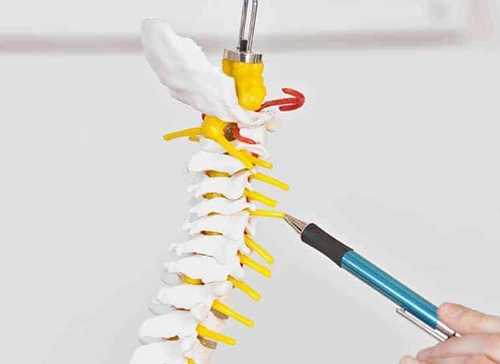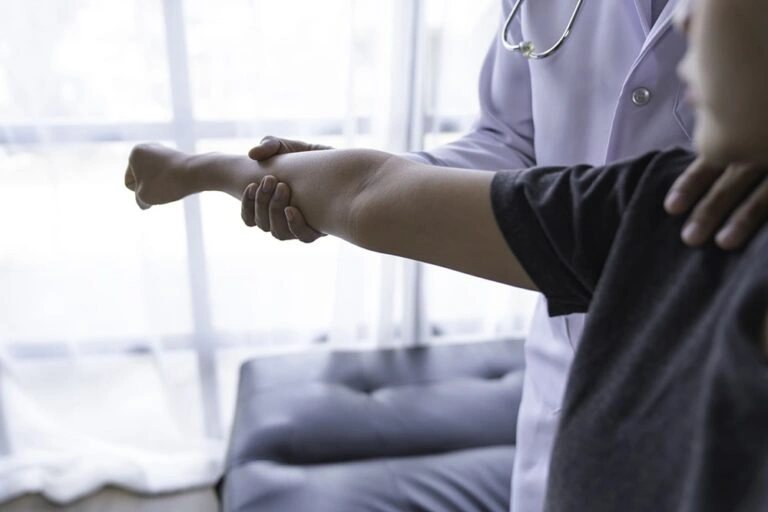Navigating back pain can be confusing, especially when medical jargon begins to sound like gibberish. Two common culprits in the world of spinal discomfort are herniated discs and pinched nerves. Both can be proverbial thorns in one’s back, yet there are distinctive traits that can help to differentiate one from the other.
If you find yourself in the unenviable position of experiencing back pain and trying to narrow down the cause, read on nine telltale signs that can help you understand whether it’s more likely a herniated disc or a pinched nerve.
1. The Core Issue: Disc Displacement Vs. Nerve Entrapment
A herniated disc, also known as a slipped or ruptured disc, arises when the gel-like material within a spinal disc protrudes. This can happen due to trauma, degeneration, or lifting something heavy. A large herniated disc is any spinal disc that extends beyond its normal anatomy. It may cause symptoms such as severe back and leg pain. In some cases, a large disc herniation in the cervical spine may even compress the spinal cord within the spinal canal, causing numbness and stiffness.
On the other hand, a pinched nerve is compressed by surrounding tissues, such as bones, cartilage, muscles, or tendons. The core difference is that a herniated disc is part of the issue, potentially causing the pinching. In contrast, a pinched nerve could be due to a range of other causes, with the herniated disc being one possibility.
Understanding this distinction can help in diagnosis and subsequent treatment. For example, rest for one to three days is advised if the pain from a herniated disk is severe. Even massive disc herniations can be treated conservatively if early progress is shown.
2. Pain Patterns: Location Tells the Story
Pain is a complex sensation, and where you feel it can tell a lot about its source. A herniated disc often causes localized pain at the point of injury, which can radiate outwards, following the path of the affected nerve. For instance, if the herniation occurs in your lower back, you might sense pain, tingling, and numbness down your leg – a condition known as sciatica.
A pinched nerve can also lead to radiating pain but is typically more localized around the spine, with less intense radiation. A common indication of a pinched nerve is sharp pain, burning, or a “pins and needles” sensation localized around the back and neck regions.
3. Sensory Feedback: Numbness and Tingling
When it comes to sensory experiences, a herniated disc and a pinched nerve can lead to numbness and tingling, often called paresthesias. The critical factor here is the area affected. With a herniated disc, the symptoms are more likely to extend the entire length of a primary nerve root, such as the leg for sciatica or the arm for a cervical disc herniation.
For a pinched nerve, the numbness and tingling may cover more specific areas corresponding to the particular nerve under pressure. For example, a pinched nerve in the wrist, known as carpal tunnel syndrome, typically leads to tingling and numbness in the thumb, index, middle, and part of the ring fingers.
4. Motor Control: Muscle Weakness and Atrophy
The nervous system plays a critical role in controlling your muscles, so it follows that both herniated discs and pinched nerves can result in motor dysfunctions. With a herniated disc, if the compressed nerve root is responsible for a muscle group, you may experience weakness or difficulty lifting or moving the affected limb.
When a pinched nerve is at play, the muscle weakness can be directly linked to the specific nerve affected, leading to more localized and often less severe weakness. Muscle atrophy, or involuntary twitching, may occur over time due to sustained nerve compression.

5. Aggravating Factors: What Makes It Worse?
Understanding what exacerbates your symptoms can be a valuable clue in pinpointing the cause of your back pain. With a herniated disc, activities that increase intradiscal pressure are potential triggers. This includes sneezing, coughing, or bending over, which increases pain if a disc is compromised.
If you have a herniated disc, avoiding activities that involve bending, twisting, and lifting is essential, as these can worsen the pain.
For a pinched nerve, the issue is less about the action than the position. To avoid aggravating a pinched nerve, certain activities should be avoided. Specific postures or movements that further compress the nerve can lead to an uptick in pain. This means activities involving repetitive motions or sustaining a particular position may cause increased symptoms.
6. Onset and Duration of Symptoms: Sudden Vs. Gradual
Often, the way symptoms appear can be a clue to their cause. A herniated disc can result from sudden or traumatic events, with symptoms appearing almost immediately or shortly after. The pain might be quite severe and debilitating, limiting movement.
In contrast, a pinched nerve can have a more stealthy onset. Pain and other symptoms may develop gradually, perhaps due to repetitive motion or prolonged poor posture. This means they can catch the sufferer off guard, with the pain becoming chronic over time if it is ignored.
7. Affected Area: Back and Beyond
The specific location of symptoms can be quite different between a herniated disc and a pinched nerve. A herniated disc affects the back primarily but may radiate to the arms or legs, as per the affected nerve root. The pain is often felt along the sciatic nerve in the leg (sciatica) or the brachial plexus in the arm (brachialgia).
Depending on location, a pinched nerve can cause symptoms in multiple body areas. For example, a pinched nerve in the lower back may lead to symptoms in the buttocks, legs, and feet, whereas a pinched nerve in the neck could result in issues with the shoulders, arms, and hands.
8. Diagnostic Clues: Imaging and Tests
Diagnosing the source of your back pain often involves imaging tests. For a herniated disc, an MRI or CT scan can clearly show the disc displacement and any resultant compression of nerve roots. X-rays may also show if there is any abnormality in the spine, such as a narrowing of the spinal canal where a herniation may occur.
For a pinched nerve, electromyography (EMG) or nerve conduction studies can be used to assess the electrical activity in the muscles and the speed of nerve signal transmission, respectively. These tests help identify where the nerve is pinched and to what extent.

9. Treatments: Addressing the Root Cause
Finally, understanding the differences in treating a herniated disc versus a pinched nerve can be enlightening. Treatment for a herniated disc often begins with conservative measures such as rest, anti-inflammatory medications, physical therapy, and potentially epidural steroid injections. Surgery, such as a discectomy, may be considered if symptoms persist.
Pinched nerve treatments may overlap with those for a herniated disc. Physical therapy and medications can help manage pain and symptoms, and in some cases, surgery is necessary to relieve the compression. However, the emphasis may shift somewhat to address the underlying cause of the compression, which can range from bone spurs to degenerative conditions.
While this list provides distinct differences between herniated discs and pinched nerves, it is essential to seek professional medical advice if you are experiencing back pain or related symptoms. Healthcare professionals can provide a thorough diagnosis and recommend an appropriate treatment plan. Remember, the road to back pain relief may be winding, but understanding these critical distinctions is the first step toward effective treatment and recovery.
-
What Is a Pinched Nerve and What Does It Feel Like
A pinched nerve arises when undue pressure from surrounding tissues compresses nerve structures, disrupting their function. The hallmark sensation is a sharp or burning pain, often accompanied by numbness or a ‘pins and needles’ feeling, which can radiate along the nerve pathway. This discomfort may worsen with specific movements or during rest.
-
What Is a Herniated Disc and What Does It Feel Like
A herniated disc occurs when the nucleus of a spinal disc pushes through its outer ring due to wear, injury, or strain. The extruding material may impinge on nearby nerves. Patients usually report an intense, localized discomfort in the affected region, potentially along with pain that extends down one leg.
-
How Do Pinched Nerves Differ From Herniated Discs
While both conditions provoke pain by affecting nerves, they are different conditions. Pinched nerves are usually caused by the pressure placed on the nerve. In contrast, herniated discs involve structural damage to the discs. Although a herniated disc may cause a pinched nerve, by itself, it is a separate condition.
The Science of Pinched Nerves and Herniated Discs
As noted above, pinched nerves and herniated discs are not the same condition. They are, however, often linked. A herniated disc can contact and effectively “pinch” a nearby nerve. Fortunately, conservative therapies have proven effective at managing these conditions. Here are a few studies about the two conditions. The first two deal with prevalence, and the last two with conservative treatment.
In a study published by Elsevier in ScienceDirect, researchers found that 46.2% of people with lumbar disc herniations (LDH) also suffered from long term low back pain (LBP). This contrasts to 11.9% of the general population.
Another study in the Indian Journal of Pain focused on cervical radiculopathy, a condition usually caused by pinched nerves in the neck. The research found that 30% of musculoskeletal disorders annually reported by IT professionals were neck pain-related. And of that 30%. a full 50% were the result of cervical radiculopathy (i.e. a radiating pinched nerve).
A study available on Hindawi focused on the effectiveness of conservative treatment in managing low back pain due to lumbar disc herniation. The research affirmed that non-surgical interventions (specifically non-surgical spinal decompression therapy or NSDT), especially when combined with education about the condition, could significantly alleviate the symptoms of herniated discs and enhance quality of life.
Lastly, research from the National Library of Medicine discusses a case study in which a 56-year-old man suffering from non-traumatic chest pain – as well as a few other symptoms – was examined. The evaluation determined that the underlying cause of his issues was cervical radiculopathy (pinched nerves in the neck that radiate pain elsewhere in the body). The ailment was treated conservatively with chiropractic care, and the symptoms abated.
As you can see, chiropractic care has proven effective against pinched nerves and herniated discs. Now, let’s dig in a little more.
Understanding Pinched Nerves
Symptoms of a Pinched Nerve
The discomfort from a pinched nerve can range from mildly distracting to severely debilitating. Symptoms often start with numbness or decreased sensation in the area served by the nerve.
This can be followed by a sharp or burning pain that may radiate outward. Some individuals experience a tingling sensation like the feeling of a limb ‘falling asleep.’ Sometimes muscles along the path of the nerve feel weak or spasm. If untreated, these symptoms can persist, becoming chronic and potentially leading to nerve damage.
Causes of a Pinched Nerve
Pinched nerves are usually the result of other conditions putting pressure on nerve roots. Repetitive motions or maintaining the same position can cause this, as can obesity. Herniated discs, arthritis, bone spurs, and spinal stenosis are other common culprits.
Sometimes, even a sudden injury or accident can displace tissue, leading to a pinched nerve. This assortment of potential causes makes pinched nerves a relatively common, though uncomfortable, ailment.
Diagnosis of a Pinched Nerve
Diagnosing a pinched nerve typically involves a thorough physical examination during which a healthcare provider reviews the patient’s history and conducts a series of neurological tests to pinpoint the affected nerve.
Sometimes imaging tests such as MRI, CT scans, or X-rays are ordered to visualize the extent of the compression. Electromyography (EMG) and nerve conduction velocity (NCV) tests can also gauge the electrical activity in muscles and the speed of signals traveling through nerves. All these techniques serve to increase the clarity of the diagnosis.
Exploring Herniated Discs
Symptoms of a Herniated Disc
The start of a herniated disc can be marked by a sudden sharp pain in the lower back or neck, depending on its location. This pain may intensify when sitting, coughing, or sneezing, often extending to other body parts. Numbness or a tingling sensation might appear in the limbs, signifying an affected nerve.
In severe cases, patients may experience muscle weakness or difficulty in performing basic movements without pain. These symptoms signal that the disc material is pressing against nerve tissue and disrupting normal function.
Causes of a Herniated Disc
A herniated disc can arise from several factors. For some, it might involve just a poor lifestyle. For others, age-related wear and tear, known as disc degeneration, maybe the culprit; our spinal discs dehydrate and lose elasticity as we age. This makes them more susceptible to damage like tearing.
Physical strain or a traumatic injury can also lead to herniation, mainly if it involves lifting heavy objects improperly. Obesity also increases the risk by putting excessive stress on the discs. Likewise, certain repetitive activities or occupational hazards can contribute to the gradual development of a herniated disc.
Diagnosis of a Herniated Disc
Diagnosing a herniated disc begins with a physical exam, where a doctor will check for nerve function and muscle strength and assess whether pain increases with movement. Physicians typically resort to imaging tests such as MRI or CT scans to confirm the diagnosis.
These tests can produce detailed pictures of the spine’s soft tissues, including the discs and nerves. In some specialized cases, a myelogram — an X-ray combined with a contrast dye injection into the surrounding spinal fluid — may pinpoint pressure on the spinal cord or nerves due to a herniated disc.
Management and Treatment
When addressing the discomfort that comes with pinched nerves and herniated discs, there exists many different treatment options available. The best choice often depends on the severity of symptoms. It can range from conservative, non-surgical approaches to more invasive surgical interventions. We’ll discuss a few in more detail below.
Non-surgical Options for Managing Pinched Nerves and Herniated Discs
Non-surgical treatments favor managing symptoms and promoting the body’s natural healing process. Options include physical therapy, which strengthens muscles and improves flexibility, and medications such as nonsteroidal anti-inflammatory drugs (NSAIDs), which can reduce inflammation and relieve pain.
Additionally, epidural steroid injections may temporarily relieve inflammation near the impinged nerves.
Chiropractic Care as a Treatment Option
Of course, we cannot forget chiropractic care. Chiropractic care offers a non-invasive approach to treating pinched nerves and herniated discs. It aims to realign the spine and alleviate pressure on affected nerves. Through controlled spinal manipulations, chiropractors work to reduce nerve irritability and improve mobility.
Techniques such as flexion-distraction therapy gently stretch the spine, which can help move the disc away from the nerve. Patients often report significant pain relief after a series of treatments. All told, chiropractic care can be integral to a comprehensive management plan.
It also has a formidable track record in terms of safety. Chiropractic has even been used on children – as this journal article from Elsevier on Science Direct shows – and has worked remarkably well.
Surgical Interventions for Severe Cases and When They are Warranted
Surgery is generally considered when other treatments have failed to provide adequate relief or if neurological symptoms progress. Procedures such as a microdiscectomy or laminectomy remove the portion of the disc or bone that compresses the nerve.
Surgery may also be necessary if the patient experiences any of the following issues:
- significant muscle weakness
- loss of bowel or bladder control,
- when the disc herniation is particularly severe.
Surgical decisions are made on a case-by-case basis, often after careful evaluation of diagnostic imaging results and clinical assessment.
Rehabilitation and Recovery Considerations Post-treatment
Whether or not surgical or non-surgical methods are used, rehabilitation plays a crucial role in full recovery. Customized physical therapy programs help restore function, improve strength, and prevent future injuries. Regular chiropractic sessions can help maintain posture and spinal alignment.
Implementing ergonomic changes alongside regular exercise can also support long-term health. Recovery time will differ depending on the type of treatment and individual patient factors, but adherence to the instructions and guidance given by healthcare providers is essential for a successful recovery.
Common Triggers of a Pinched Nerve
Many kinds of conditions often provoke pinched nerves. These include:
- Herniated discs
- Carpal tunnel syndrome
- Bone spurs
- And sports injuries.
Repetitive motions, obesity, diabetes, and even pregnancy are also known to increase the risk. Age-related changes, including spinal disc degeneration and arthritis, can compound the likelihood of nerve compression.
Activities to Avoid with a Pinched Nerve
To prevent aggravating a pinched nerve, avoiding activities involving repetitive motion or excessive wrist flexion, like prolonged typing or assembly line work is wise. Heavy lifting or high-impact sports can also exacerbate symptoms – as can any activity that strains the back, neck, or other affected areas.
Herniated Disc Recovery
Recovery from a herniated disc generally entails:
- Rest
- Anti-inflammatory medications
- Physical therapy
- And chiropractic care.
Following a guided exercise program is critical to strengthening the spine and surrounding muscles to support your recovery. But you should also avoid movements that may worsen the herniation.
Radiculopathy
Where Do Symptoms Occur When You Have a C5-C6 Pinched Nerve?
A pinched nerve at the C5-C6 level in the cervical spine can result in weakness in the biceps and wrist extensors, numbness or tingling within the thumb and index finger, and pain that may radiate down the arm to the hand. This condition is a form of radiculopathy, where nerve root issues cause symptoms to travel (radiate) to other locations along the neural pathway.
Symptoms of Bulging Disc at L5 S1
The L5 S1 disc, located at the base of the spine, can cause sciatica when bulging, marked by shooting pain down the buttocks and back of the leg. Other symptoms may include lower back pain, foot drop, or numbness in the legs and feet due to nerve irritation. It, too, is a form of radiculopathy.
Before parting, we must note that it is essential to seek medical input from a healthcare professional (chiropractor, physical therapist, etc…) before implementing changes to your health regimen in any way – be it starting or stopping an exercise, changing medications, or what-have-you.
Conclusion
So, end your struggle with pinched nerves or herniated discs. Don’t let the pain they cause dim the beautiful Alaskan life waiting for you outside your door. We at Better Health Alaska can be your ally in reclaiming a pain-free life. Our expert care in Anchorage combines precision with compassion, offering personalized treatments that address the root of your discomfort.
Your journey starts with just one call. Connect with Better Health Alaska now and take the first step towards lasting relief.









